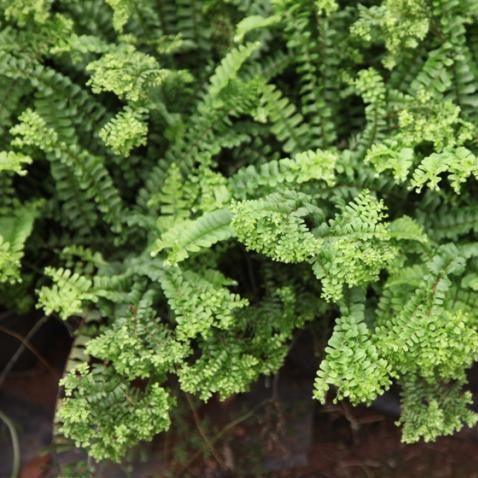- Common name:
- Crested Sword Fern, Petticoat Fern
- Category:
- Ferns, Groundcovers, Indoor Plants
- Family:
- Polypodiaceae or Fern family
-
Petticoat fern, also known as Squirrel's Foot fern or Button fern, is a beautiful indoor plant that belongs to the Davalliaceae family. This fern is native to tropical regions of Asia and the Pacific, and it is popular among houseplant enthusiasts for its unique fronds that resemble fluffy petticoats or squirrel's feet. Here is a full guide on growing, caring for, and benefits of the petticoat fern plant:
Growing:
-
Light: Petticoat ferns prefer bright, indirect light, but they can tolerate lower light levels. Avoid direct sunlight as it can scorch the leaves.
-
Temperature: These ferns thrive in warm temperatures ranging from 60°F to 75°F (15°C to 24°C). They don't like extreme temperature changes or drafts.
-
Soil: Use a well-draining potting mix that is rich in organic matter. Avoid heavy soils that can retain too much moisture and cause root rot.
-
Water: Water the plant when the top inch of soil feels dry to the touch. Avoid overwatering as it can lead to root rot. Water less frequently in winter when the plant is in its dormant phase.
-
Humidity: Petticoat ferns prefer high humidity levels. You can increase humidity by placing a humidifier near the plant or placing a tray of water near the plant.
-
Fertilizer: Feed the plant once a month during the growing season (spring and summer) with a balanced fertilizer. Avoid fertilizing during the dormant season (fall and winter).
-
Repotting: Repot the plant every two to three years in a slightly larger pot to accommodate its growing root system.
Care:
-
Pruning: Remove any yellow or dead fronds to maintain the plant's health and appearance.
-
Propagation: Petticoat ferns can be propagated through division or spores. Division is the easiest method, and it involves separating the plant into smaller sections and repotting them.
-
Pests and diseases: Petticoat ferns are susceptible to pests like spider mites, mealybugs, and scale insects. Keep an eye out for any signs of infestation and treat them immediately with an insecticidal soap or neem oil. The plant can also suffer from fungal diseases like root rot and leaf spot, so avoid overwatering and ensure good air circulation around the plant.
Benefits:
-
Air purification: Like most ferns, petticoat ferns are excellent air purifiers and can remove pollutants from indoor air.
-
Aesthetics: The unique fronds of the petticoat fern can add a touch of elegance and whimsy to any indoor space.
-
Stress relief: Caring for plants like the petticoat fern can provide a calming effect and reduce stress levels.
In summary, the petticoat fern is an easy-to-care-for indoor plant that can add a unique and charming touch to any space. With the proper growing conditions and care, this fern can thrive and provide many benefits to its owner.



